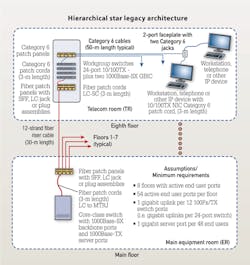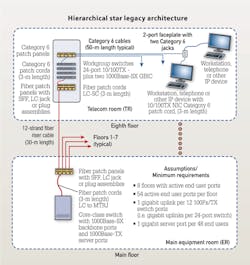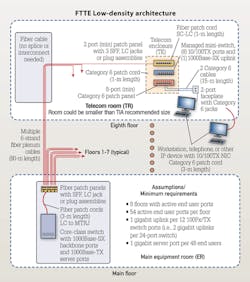How fiber can help make your network "greener"
From the April, 2013 Issue of Cabling Installation & Maintenance Magazine
Lower energy consumption, reduced waste and sustainable architectures are all characteristics that make fiber infrastructure an environmentally advantageous choice.
By Alfred Flores, Berk-Tek and Loni L. Le Van-Etter, 3M
Increasingly information technology (IT) departments are being asked to make their networks "greener" as part of the overall push toward sustainability in business. Several recent studies have focused on the impact that the buildings sector has on United States energy consumption. According to the Energy Information Administration (EIA; www.eia.gov), in 2010 roughly 41 percent of total U.S. energy consumption was used in buildings--surprisingly this sector uses 44 percent more energy than the transportation sector and 36 percent more than the industrial sector. Taking a global perspective, the buildings sector accounts for 7 percent of global energy consumption.
And it's not just energy consumption. Gartner analysts report that IT activity accounts for about 2 percent of total global carbon dioxide emissions--about the same as produced by the entire aviation industry.
Spending to bring IT activity into a greener space is expected to be significant. Looking at just the data center market, Pike Research reports that the amount of money spent to make data centers greener over the next four years will grow to $45 billion by 2016, at a compound annual growth rate of nearly 28 percent.
While the goal to improve the sustainability of networks is both real and ambitious, when it comes to structured cabling, best practices for achieving sustainable networks are still being defined. While Leadership in Energy and Environmental Design (LEED) focuses primarily on building construction, a new organization called the STEP Foundation (www.thestepfoundation.org) has stepped up to focus on the technology systems that operate to support sustainable buildings.
STEP, which stands for Sustainable Technology Environments Program, is establishing a ratings plan and is writing guidelines that will bring sustainability to technology systems. At its core, STEP is intended to bring sustainability to the process of planning, designing, integrating and operating technology systems, as well as reduce long-term environmental impact from technology deployment. The STEP Foundation has issued guidelines about the areas it intends to cover and its founding organizations, including CompTIA, InfoComm and TIA, are working to develop the specifics, including cooperating with TIA on a standard for sustainability attributes in technology systems. STEP guidelines will provide a tool for owners and technology providers to implement sustainable practices in their technology projects and establish technology industry benchmarks for sustainable energy and materials practices.
Working on the standards side of the equation is TIA's TR-42.10 committee, which was formed to develop and maintain voluntary standards, guidelines and recommendations for sustainable information communications technology, with the goal to reduce long-term environmental impact from technology deployment. TR-42.10 also approved a project, preliminarily titled "Standard for Sustainable Information Communications Technology."
From the perspective of the TIA's Fiber Optics Technology Consortium (FOTC; formerly the Fiber Optics LAN Section), the good news is that there are many characteristics inherent to optical fiber that make it suitable for supporting building sustainable structured cabling. This focus on making structured cabling greener is attainable.
What STEP includes
STEP was envisioned to encompass all low-voltage building and communication technology into a phase-by-phase, sustainable deployment process. STEP guidelines define "sustainability" by reducing the ongoing energy consumption of information technology systems, by enabling the reduction of raw materials in the deployment of information technology solutions, and improvements in indoor environmental quality of technology-rich installations.
One focus area of the new STEP program is geared toward helping companies develop structured cabling systems that are more sustainable. Although some of the specifics are not yet in place, STEP has published a guide that addresses several key elements explaining the intent of the credit and the rating system. A copy of the guide can be downloaded from the STEP Foundation's website.
Some of the key goals related to cabling infrastructure as outlined in the STEP guidelines are as follows.
1. Minimize energy consumption. Reduce energy consumption through the careful analysis of existing energy use, the associated costs, and identification of strategies to minimize future energy consumption.
2. Reduce waste. Reduce/eliminate e-waste by identifying re-use, recycling or end-of-life programs for existing equipment that is nearing decommissioning, as well as considerations for the future in the selection of new equipment for purchase. This objective includes looking at:
a. Lowering energy consumption
b. Reducing total cost of ownership (TCO)
c. Optimizing infrastructure design for sustainability
i. Eliminate unnecessary redundant components from the system.
ii. This may take the form of consolidation of hardware into a central location through the use of traditionally disparate technology for multiple purposes, i.e. combining life-safety and performance PA systems, thereby halving the infrastructure required.
iii. Eliminate unnecessary cabling (and therefore typically related conduits and pathways) from the system through a thorough review of signal distribution options including structured cabling, signal distribution, power requirements, and identifying opportunities to share equipment and resources between multiple physical spaces.
d. Provide scalability
e. Reduce construction materials
How fiber can help
Optical fiber-based networks work well with the objectives outlined in the STEP program because they have inherent characteristics that support a move toward networks that reduce energy consumption, reduce waste and lower the TCO for a network through longer product lifecycles.
Optical networks lower energy consumption. One of the benefits of deploying an optical network is that they consume less energy than copper-based systems, not just initially, but also over the life of the network. Recent innovations in copper chipsets for 10GBase-T applications have brought power consumption for copper networks down to between 1 and 2 watts over shorter distances and about 3.5W at full 100-meter reach capability. Fiber networks, in comparison, may use less than 1W to transmit the 10-GbE signal over the IEEE specs of 300 meters for Om3 or 400 meters for Om4 fiber. Over time the power savings from a fiber-based network can be meaningful, especially in data center applications where there may be thousands of connections. Lower energy consumption also can help reduce CO2 emissions.
According to the Environmental Protection Agency (EPA) Green Power Equivalency Calculator Methodologies, the emission factor to calculate CO2 greenhouse gas (GHG) savings is 6.8956 x 10-4 metric tons CO2 / kWh. (Source: Green Power Equivalency Calculator Methodologies, updated April 2011, www.epa.gov/greenpower) So, for example, in a data center environment where thousands of ports are being used, a fiber-based architecture could save hundreds or thousands of kWh per year compared to the equivalent copper-based network just in port power consumption. This would in turn equate to substantial reductions in CO2 GHG, which supports a greener, more-sustainable environment.
Because fiber networks use less energy to power the signal, they also generate less heat--and therefore require less cooling. The EPA reports that each kilowatt of network power in a data center requires a kilowatt of power for the cooling devices. So not only do you reduce energy use by powering a fiber-optic network, you also need less energy to cool it. In addition to the energy savings, this also means you need less heating/ventilation/air-conditioning (HVAC) equipment, saving on materials and floor space. Fiber solutions lower your energy consumption, year after year.
Optical-fiber networks help reduce water and lower TCO. For data center applications, fiber installations often require fewer line cards than copper because fiber line cards typically have higher densities--or more ports per card. This could potentially lead to fewer chassis. The fiber patch cords and cables that connect the equipment can also be of high-density (multi-fiber) design, further condensing solutions. Fiber cables supporting high bandwidth over longer distances are typically of smaller diameter constructs and weight than copper cords, which can contribute to better airflow for cooling requirements. This approach helps ensure that less material is used, as well as reducing energy consumption and enabling a smaller footprint.
Optical fiber cables typically have a longer infrastructure lifespan, which supports a sustainable installation. The inherently high bandwidth in optical fiber means that once the cable is installed, it has a potential working life of 25-plus years without recabling, thereby providing network managers a migration strategy that minimizes materials consumption and maximizes support for emerging topologies. The longer usable lifespan also reduces the total cost of ownership for the structured cabling part of the network. Finally, it also means that fewer cables need to be discarded because of obsolescence.
Optical fiber supports sustainable architectures. The high bandwidth and long link lengths supported by fiber networks enable local area network (LAN) architectures that minimize the use of electronics--saving energy, reducing the materials needed, and creating a network with the bandwidth to support future applications. Two of the architectures that are being discussed are fiber-to-the-telecom-enclosure (FTTE) and passive optical LAN (POL).
Fiber-to-the-telecom-enclosure architectures allow you to use the long runs supported by fiber to expand an optical fiber backbone from the equipment room through a telecommunications room (TR) to a telecommunications enclosure (TE). FTTE networks allow electronics to be centralized, reduce the need for HVAC equipment, and offer greater flexibility. This makes them ideal for environments with many moves, adds and changes (MACs). The FTTE architecture is based on the TIA-569-B pathways and spaces technical standard, which defines the TE, and on TIA-568-C.1, which defines the cabling when a TE is used.
FTTE architectures have been deployed in office environments successfully for many years. Depending on the user's needs, FTTE can be deployed in low- or high-density configurations. Modeling conducting by the Fiber Optics Technology Consortium in their downloadable cost model suggest that compared to traditional hierarchical star architectures (which use fiber in the backbone and unshielded twisted-pair copper in the horizontal), FTTE architectures offer the potential for cost savings by reducing the amount of electronics needed and freeing up space that typically was dedicated to TRs.
A low-density system might use one or two inexpensive eight-port Ethernet miniswitches as an example. These switches have eight, 10/100 copper ports and one, 1-Gbit/sec fiber uplink. A high-density FTTE design might use commonly available 24- or 48-port switches. These switches are configured with one, 1-Gbit/sec uplink port per 12, 100Base-TX user ports. This relatively high work-area-to-backbone-port ratio provides better performance than is typically provided to enterprise users.
Keep in mind that FTTE centralized active electronics solutions from the equipment room may require higher fiber counts through the riser, which might be a concern for larger building installations. Also, the connectivity from each zone area to the work area still requires a connection from the zone to the outlet; that media can be fiber, copper or wireless.
Passive optical LAN (POL) is an emerging network architecture that is gaining in popularity in the LAN environment because of its potential low initial and ongoing energy savings and optimized networking features for supporting high-bandwidth delivery of converged services. Many equipment vendors implementing POLs design the system to the ITU-T G.984 Gigabit Passive Optical Network (GPON) technology standard that has been successfully deployed for millions of users in the U.S. and around the world as a fiber-to-the-premises solution that is now gaining inroads into enterprise applications.
Unlike most LAN architectures, which use duplex multimode optical fibers, POLs use singlemode fibers.
POL networks do not require the additional network layer of active workgroup switches on every floor, or even in every building on a campus. Instead, they use signal aggregation over a single fiber from the equipment room to the passive (non-powered) optical splitter, which then distributes and branches the communications signals to the optical network terminals (ONTs) located in or near the work areas. The use of splitters can significantly reduce the linear feet of fiber required compared to alternatives. Effectively, one singlemode fiber can provide service to many users.
The use of singlemode fiber in the horizontal of office-oriented networks is a relatively new addition to the TIA cabling standards. In February 2009, the Telecommunications Industry Association TR-42 Engineering Committee published TIA-568-C.1, which was the first revision to recognize duplex singlemode fiber for use in the horizontal. On August 14, 2012, TR-42 issued an addendum to the TIA-568-C.0 Generic Telecommunications Cabling for Customer Premises standard that adds PON technology standards as supported singlemode fiber applications for the LAN.
The potential advantages of a passive network include reduced HVAC requirements and costs for cooling racks of active electronics, lower power consumption on a per-Ethernet port basis compared to the overall traditional active switched Ethernet networking solution, reduced amount of uninterruptible power supply (UPS) backup power required for centralized active electronics, and reduced materials for the infrastructure cabling, connectivity and apparatus.
An all-fiber LAN can allow for significant savings in building construction square footage required for telecommunications and related materials.
Building with sustainability in mind today will help you position your location in securing STEP credits in the future. According to Allen Wiedman, chairman of the STEP Foundation, companies that follow industry best practices likely will find that their installation will earn STEP credits as the specific rating system evolves. It is certainly worth reading the STEP guidelines now and taking the overall recommendations into advisement. STEP is on track to have its core document released by mid-2013.
The TIA TR-42.10 committee plans to have the first iteration of its standard ready for review in early 2013, with the potential for a ballot vote in June. ::
Alfred Flores is product manager for preterminated assemblies at Berk-Tek, a Nexans company (www.berktek.com). Loni L. Le Van-Etter is a senior product development specialist and application engineer for in-building converged networks for the 3M Communication Markets Division (www.3m.com). They co-authored this article on behalf of the Telecommunications Industry Association's Fiber Optics Technology Consortium (FOTC; www.tiafotc.org), formerly the Fiber Optics LAN Section.
View Archived CIM Issues


